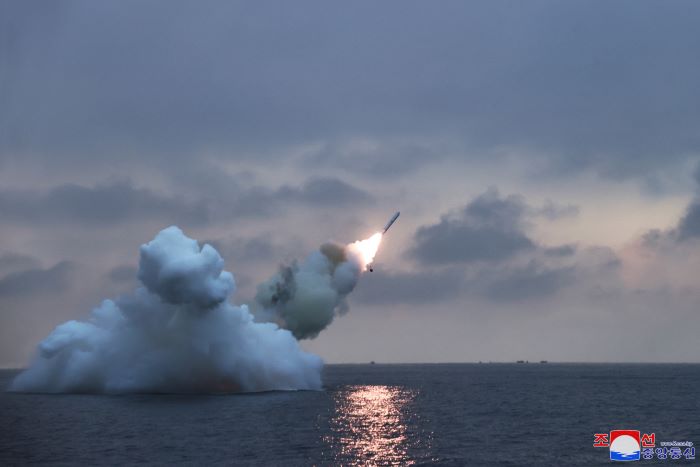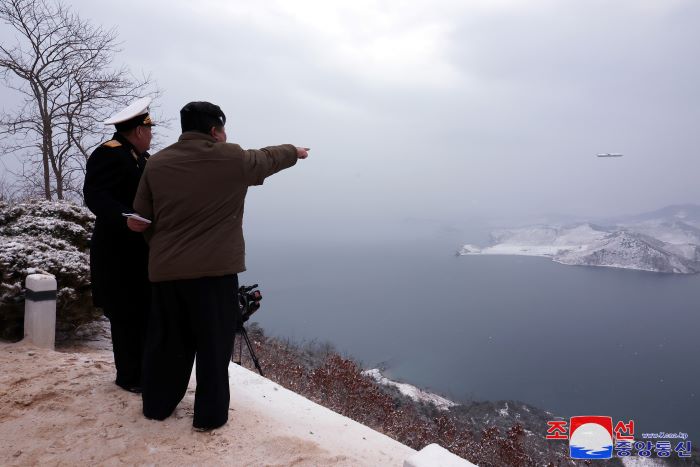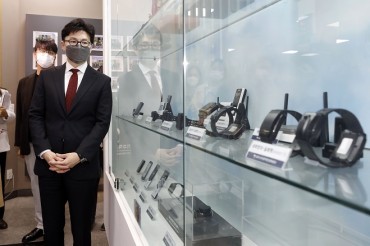
This photo, carried by North Korea’s official Korean Central News Agency on Jan. 29, 2024, shows the North’s firing of submarine-launched cruise missiles the previous day. (For Use Only in the Republic of Korea. No Redistribution) (Yonhap)
SEOUL, Jan. 29 (Korea Bizwire) – North Korea’s recent series of missile launches using diverse platforms indicate its efforts to develop more powerful and harder-to-detect weapons, posing a challenge to South Korea’s missile defense system, experts said Monday.
North Korea tested an array of missiles under development at the start of the year, including a solid-fuel intermediate-range ballistic missile tipped with a hypersonic maneuverable controlled warhead, a underwater nuclear attack drone and submarine-launched cruise missiles.
North Korean leader Kim Jong-un on Sunday oversaw the test-fire of a newly developed submarine-launched strategic cruise missile, named the Pulhwasal-3-31, which flew slightly over 2 hours and hit preset targets in the East Sea, the state media reported.
The Pulhwasal-3-31 is a new generation of strategic cruise missile that Pyongyang said it had only tested for the first time Wednesday, firing multiple missiles toward the Yellow Sea.
Photos released by the state media showed a missile launched from the water at an angle of about 45 degrees, but it was not immediately clear whether it was fired from a submarine or a submersible ballistic missile test stand barge.
“We are weighing the possibility of North Korea’s exaggerating the flight time (of the missiles),” Col. Lee Sung-jun, the spokesperson of the Joint Chiefs of Staff, told a regular press briefing.
South Korean and U.S. intelligence authorities are analyzing the missiles’ flight time and launch platforms.
Experts say the submarine-launched cruise missiles could pose a serious threat to South Korea’s air defense system if perfected as they are harder to detect and shoot down due to their low-flying altitude and precision strike capabilities.
“Unlike ballistic missiles, which focus on mass destruction of long-range targets, cruise missiles are capable of precision strikes at close range, therefore posing a substantial threat to South Korea,” Choi Il, the head of the Submarine Research Institute, said.
During Kim’s visit to Sinpo, the North’s major shipyard for submarines, he also discussed issues related to the building of a nuclear-powered submarine and other new types of warships.
In September last year, North Korea unveiled what it claimed was its first tactical nuclear attack submarine capable of carrying out an underwater nuclear attack. At that time, Kim announced a plan to build more submarines, including a nuclear-powered sub.

This photo, carried by North Korea’s official Korean Central News Agency on Jan. 29, 2024, shows the North’s leader Kim Jong-un (C) overseeing the country’s test fire of submarine-launched cruise missiles the previous day. (For Use Only in the Republic of Korea. No Redistribution) (Yonhap)
Nuclear-powered submarines were part of a list of sophisticated military assets Kim unveiled in 2021, along with hypersonic missiles, multiple-warhead missiles, spy satellites, solid-fuel long-range missiles and submarine-launched nuclear missiles.
Choi, a retired submarine captain, said the North’s test-firing of two missiles appears to be aimed at demonstrating its capability of simultaneously attacking multiple targets.
“Cruise missiles are capable of launching simultaneous attacks from various directions by setting invisible flight paths in the sky,” Choi said.
The cruise missile, presumed to be capable of carrying a nuclear warhead, adds threats to the South Korean air defense system, in addition to sophisticated ballistic missiles with varying ranges, warheads and launch platforms.
Earlier this month, the North said it flight-tested a new solid-fuel intermediate-range missile (IRBM) tipped with a hypersonic warhead, which could potentially target U.S. military bases in Guam and Japan.
If perfected, the combination of a solid-fuel IRBM tipped with a hypersonic maneuverable controlled warhead could be a “game changer” because of its speed and maneuverability, experts say.
Hypersonic missiles travel at a speed of at least Mach 5 — five times the speed of sound — and they are designed to be maneuverable on unpredictable flight paths and fly at low altitudes.
At Mach 5 or higher, a missile would be able to traverse the 195 kilometers (121 miles) between Pyongyang and Seoul in one to two minutes.
Missiles with built-in solid propellants can be made ready to launch faster and are easier to move and conceal, which makes them harder to detect and intercept.
“North Korea seems to be boasting its hypersonic missile to demonstrate its capability of evading South Korea’s missile defense system, such as its PAC-3 and THAAD systems,” said Shin Jong-woo, a senior researcher at the Korea Defense and Security Forum.
South Korea operates the Terminal High Altitude Area Defense system, designed to shoot down hostile missiles at altitudes of 40-150 kilometers, and the Patriot Advanced Capability-3 Missile Segment Enhancement system, which are capable of intercepting missiles at altitudes of 40 km and lower.
(Yonhap)






